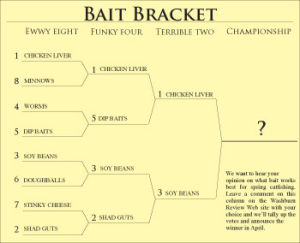Spring catfishing spawns its own March Madness
March 22, 2009
My spring break, in a nutshell, was spent dipping my fingers in smelly catfish bait and watching college basketball games. I don’t know whether it was the fumes from the bait or the basketball overload, but a stroke of genius (or heat) caused me to come up with the idea of a bracket system for catfish bait.
The first round-or as I like to call it the “Ewwy Eight”-presented a few good matchups, but only one upset.
No. 1 Chicken Liver vs. No. 8 Minnows
Chicken liver, a favorite amongst many catfish hunters, received the automatic number one seed. Minnows, the lowest seeded bait in the bracket, are common as bait but not as common when chasing catfish. Chicken liver, of course, wins this matchup in a blowout. Liver is an extremely effective catfish bait in any weather and location, and only gets better with age.
No. 2 Shad Guts vs. No. 7 Stinky Cheese
Shad, especially their innards, are a great source of smell to attract big cats and are generally effective in all bodies of water. As a general rule of thumb, the more disgusting the bait is, the better off you are. Stinky cheese, an old favorite of aging fishermen and perhaps underrated as a seven seed, is still up against a wall on this one. Stinky cheese can draw in big cats, but it generally is not as effective across the board as shad guts. Shad guts win in a close one.
No. 3 Soy Beans vs. No. 6 Pre-made Doughballs
Soy beans that have been left out a few days in a bucket and soaked in water are a beastly weapon against the whiskered ones and double as chum, as well as bait. Simply stick 3-4 beans on a hook, drop it near the bottom and wait. Pre-made doughballs, which are sold in almost every sporting goods outlet in the country, can be worthwhile in small ponds on hot days, but that’s about as far as their worth goes.
No. 4 Worms vs. No. 5 Dip Baits
This matchup presents the first upset, as dip baits edge past worms in the realm of catfishing. Worms can be useful when other baits aren’t working, as they are the most natural form of bait. However, dip baits are specialized for catfish and, on any given day, can be explosive. Worms are a good backup bait, but dip baits take the cake.
The second round, which I lovingly dubbed the “Funky Four,” was just as dramatic as the first round, offering another upset as the one and three seeds moved onto the finals, or the “Terrible Two.”
No. 1 Chicken Livers vs. No 5. Dip Baits
Chicken livers prevail again, as dip baits still fail under cooler conditions when compared to chicken liver. Chicken liver is really the utility player of catfish baits, the go-to bait when nothing else works.
No. 2 Shad Guts vs. No. 3 Soy Beans
Incredibly close matchup, and shad guts may have even had the edge if it weren’t for the soy beans secondary role as chum. Throwing out gobs of food to starving catfish is the essential way to fill your stringer, and using the same type of food as bait and chum is the perfect strategy to induce a lot of strikes. Beans upset shad guts.
I’d like to give the readers a chance to get involved now. With the “Terrible Two” matchup of chicken liver and soy beans, I find myself unable to declare a champion, so perhaps the democratic process is best in this situation. To vote for which bait you think works best for springtime catfishing, go to the Washburn Review Web site (www.washburnreview.org) and leave your vote as a comment on this column. You can also e-mail your vote to me at the address listed below.



